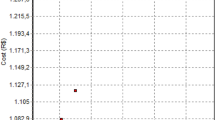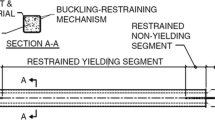Abstract
In this research, the costs as well as flexural and tensile strength of bamboo reinforced concrete material were predicted and optimized using artificial neural network (ANN) and non-dominated sorting genetic algorithm-II (NSGA-II). The inputs to the ANN were curing days and percentage bamboo content in the bamboo reinforced concrete material, while the outputs were cost, flexural and tensile strength. The ANN predicted the experimentally determined values of the tensile strength, flexural strength and costs of the bamboo reinforced concrete material excellently with correlation coefficients of 0.99635, 0.99739 and 1, respectively. Subsequently, the ANN was used as the fitness function for NSGA-II for multi-objective optimization of the cost, flexural and tensile strength of bamboo reinforced concrete material. The Pareto optimal solution obtained could serve as a design guide for engineers for optimal design of structures using cost, flexural and tensile strength of bamboo reinforced concrete material.


















Similar content being viewed by others
References
Agarwal A, Nanda B, Maity D (2014) Experimental investigation on chemically treated bamboo reinforced concrete beams and columns. Constr Build Mater 71:610–617
Ahmadi M, Naderpour H, Kheyroddin A (2017) ANN model for predicting the compressive strength of circular steel-confined concrete. Int J Civ Eng 15(2):213–221
Atuanya CU, Government MR, Nwobi-Okoye CC, Onukwuli OD (2014) Predicting the mechanical properties of date palm wood fibre-recycled low density polyethylene composite using artificial neural network. Int J Mech Mater Eng 7(1):1–20
Boğa AR, Öztürk M, Topçu İB (2013) Using ANN and ANFIS to predict the mechanical and chloride permeability properties of concrete containing GGBFS and CNI. Compos B Eng 45(1):688–696
British Standard 1881: Part 109 (1983) Method for making test beams from fresh concrete. British Standards Institution Publication, London
British Standard 1881: Part 111 (1983) Method of normal curing of test specimens (20°C. British Standards Institution Publication, London
British Standard 1881: Part 118 (1983) Method for determination of flexural strength. British Standards Institution Publication, London
BS 3148 (1980) Tests for water for making concrete. British Standards Institution Publication, London, p 1980
Cascardi A, Micelli F, Aiello MA (2017) An artificial neural networks model for the prediction of the compressive strength of FRP-confined concrete circular columns. Eng Struct 140:199–208
Douma OB, Boukhatem B, Ghrici M, Tagnit-Hamou A (2017) Prediction of properties of self-compacting concrete containing fly ash using artificial neural network. Neural Comput Appl 28(1):707–718
Duan ZH, Kou SC, Poon CS (2013) Prediction of compressive strength of recycled aggregate concrete using artificial neural networks. Constr Build Mater 40:1200–1206
Eskandari-Naddaf H, Kazemi R (2017) ANN prediction of cement mortar compressive strength, influence of cement strength class. Constr Build Mater 138:1–11
Güneyisi E, Gesoğlu M, Algın Z, Mermerdaş K (2014) Optimization of concrete mixture with hybrid blends of metakaolin and fly ash using response surface method. Compos B Eng 60:707–715
Haupt RL, Haupt SE (2004) Practical genetic algorithms. Wiley, Hoboken
Igboanugo AC, Nwobi-Okoye CC (2011) Optimisation of transfer function models using genetic algorithms. J Niger Assoc Math Phys 19:439–452
Janseen JA (1988) The importance of bamboo as a building material. International Bamboo Workshop, Kerala Forest Research Institute, India, pp 235–241
Javadian A, Wielopolski M, Smith IF, Hebel DE (2016) Bond-behavior study of newly developed bamboo-composite reinforcement in concrete. Constr Build Mater 122:110–117
Kellouche Y, Boukhatem B, Ghrici M, Tagnit-Hamou A (2019) Exploring the major factors affecting fly-ash concrete carbonation using artificial neural network. Neural Comput Appl 31(2):969–988
Khademi F, Jamal SM (2016) Predicting the 28 days compressive strength of concrete using artificial neural network. I Manag J Civ Eng 6(2):1
Khademi F, Jamal SM, Deshpande N, Londhe S (2016) Predicting strength of recycled aggregate concrete using artificial neural network, adaptive neuro-fuzzy inference system and multiple linear regression. Int J Sustain Built Environ 5(2):355–369
Khademi F, Akbari M, Jamal SM, Nikoo M (2017) Multiple linear regression, artificial neural network, and fuzzy logic prediction of 28 days compressive strength of concrete. Front Struct Civ Eng 11(1):90–99
Mashhadban H, Kutanaei SS, Sayarinejad MA (2016) Prediction and modeling of mechanical properties in fiber reinforced self-compacting concrete using particle swarm optimization algorithm and artificial neural network. Constr Build Mater 119:277–287
Mashrei MA, Seracino R, Rahman MS (2013) Application of artificial neural networks to predict the bond strength of FRP-to-concrete joints. Constr Build Mater 40:812–821
Moroz JG, Lissel SL, Hagel MD (2014) Performance of bamboo reinforced concrete masonry shear walls. Constr Build Mater 61:125–137
Naderpour H, Rafiean AH, Fakharian P (2018) Compressive strength prediction of environmentally friendly concrete using artificial neural networks. J Build Eng 16:213–219
Nwobi-Okoye CC, Umeonyiagu IE (2013) Predicting the compressive strength of concretes made with unwashed gravel from eastern Nigeria using artificial neural networks. Niger J Technol Res 8(2):22–29
Nwobi-Okoye CC, Umeonyiagu IE (2015) Predicting the flexural strength of concretes made with granite from eastern Nigeria using multi-layer perceptron networks. J Niger Assoc Math Phys 29(2015):55–64
Nwobi-Okoye CC, Umeonyiagu IE (2016) Modelling the effects of petroleum product contaminated sand on the compressive strength of concretes using fuzzy logic and artificial neural networks. Afr J Sci Technol Innov Dev 8(3):264–274
Nwobi-Okoye CC, Umeonyiagu IE, Nwankwo CG (2013) Predicting the compressive strength of concretes made with granite from eastern Nigeria using artificial neural networks. Niger J Technol (NIJOTECH) 32(1):13–21
Okiy S, Oreko BU, Nwobi-Okoye CC, Igboanugo AC (2017) Optimisation of multi input single output transfer function models using genetic algorithms. J Niger Assoc Math Phys 40:459–466
Piuleac CG, Curteanu S, Rodrigo MA, Sáez C, Fernández FJ (2013) Optimization methodology based on neural networks and genetic algorithms applied to electro-coagulation processes. Cent Eur J Chem 11(7):1213–1224
Qi C, Fourie A, Chen Q (2018) Neural network and particle swarm optimization for predicting the unconfined compressive strength of cemented paste backfill. Constr Build Mater 159:473–478
Rebouh R, Boukhatem B, Ghrici M, Tagnit-Hamou A (2017) A practical hybrid NNGA system for predicting the compressive strength of concrete containing natural pozzolan using an evolutionary structure. Constr Build Mater 149:778–789
Russell SJ, Norvig P (2003) Artificial intelligence: a modern approach. Pearson Educational Inc., Upper Saddle River
Sadrmomtazi A, Sobhani J, Mirgozar MA (2013) Modeling compressive strength of EPS lightweight concrete using regression, neural network and ANFIS. Constr Build Mater 42:205–216
Umeonyiagu IE, Nwobi-Okoye CC (2013) Predicting the compressive strength of concretes made with washed gravel from eastern Nigeria using artificial neural networks. J Niger Assoc Math Phys 23:558–559
Umeonyiagu IE, Nwobi-Okoye CC (2015a) Predicting flexural strength of concretes incorporating river gravel using multi multi-layer perceptron networks: a case study of eastern Nigeria. Niger J Technol (NIJOTECH) 34(1):12–20
Umeonyiagu IE, Nwobi-Okoye CC (2015b) Modelling compressive strength of concretes incorporating termite mound soil using multi-layer perceptron networks: a case study of eastern Nigeria. Int J Res Rev Appl Sci 24(1):19–30
Wang B, Man T, Jin H (2015) Prediction of expansion behavior of self-stressing concrete by artificial neural networks and fuzzy inference systems. Constr Build Mater 84:184–191
Yaprak H, Karacı A, Demir I (2013) Prediction of the effect of varying cure conditions and w/c ratio on the compressive strength of concrete using artificial neural networks. Neural Comput Appl 22(1):133–141
Zavala GR, Nebro AJ, Luna F, Coello CAC (2014) A survey of multi-objective metaheuristics applied to structural optimization. Struct Multidiscip Optim 49(4):537–558
Author information
Authors and Affiliations
Corresponding author
Ethics declarations
Conflict of interest
I, on behalf of my co-author declare that we do not have any conflict of interest with respect to this manuscript.
Additional information
Publisher’s Note
Springer Nature remains neutral with regard to jurisdictional claims in published maps and institutional affiliations.
Rights and permissions
About this article
Cite this article
Umeonyiagu, I.E., Nwobi-Okoye, C.C. Modelling and multi objective optimization of bamboo reinforced concrete beams using ANN and genetic algorithms. Eur. J. Wood Prod. 77, 931–947 (2019). https://doi.org/10.1007/s00107-019-01418-7
Received:
Published:
Issue Date:
DOI: https://doi.org/10.1007/s00107-019-01418-7




